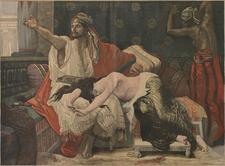Religion: Bible
Serah, daughter of Asher: Midrash and Aggadah
Shelomith 1: Bible
The story of Shelomith relates to the Egyptian practices concerning parentage and how a child is named. Shelomith herself is not explicitly described in the narrative, but the story of her son shows the punishment issued to blasphemers of God.
Shelomith 1: Midrash and Aggadah
Shelomith 2: Bible
Shelomith was the daughter of Zerubbabel, a governor (c. 520–510 B.C.E.) of the province of Yehud. The recent discovery of her name on a Judean seal suggests an honorable status in society.
Shiphrah: Bible
Shiphrah: Midrash and Aggadah
Shua's daughter: Midrash and Aggadah
Shulammite: Bible
Shunammite: Bible
The “great woman of Shunem” appears twice in the narratives about the ninth-century B.C.E. prophet Elisha. Her title suggests wealth, but also, as the story unfolds, independence of mind and faith.
Solomon’s Judgment: Bible
In this story, King Solomon is asked to consider the case of two women who gave birth to sons but, due to the death of one of their children, are fighting over the remaining child. While the story is generally cited as an example of Solomon’s wisdom, this narrative also shows the possessiveness of maternal love.
Sotah
Sotah, Tractate
Susanna: Apocrypha
Susanna’s story comes from Greek manuscripts of the Book of Daniel and is included in the Christian but not Jewish canon. She was a Babylonian Jewish woman who was falsely accused of adultery by two judges, but was saved by God through Daniel.

Tamar 2
The story of the rape of Tamar, the daughter of King David, by Amnon, her half-brother (2 Samuel 13) is told in the wake of the king’s sins of adultery and murder. Tamar’s is the only woman’s voice in the Bible to be heard in resistance to rape, though she is ultimately silenced by her full brother, Absalom. He murders Amnon in vengeance and stages an insurrection against the king, his father, while she lives the rest of her life forlorn in Absalom’s house.

Tamar: Bible
Tamar, whose story is embedded in the ancestor narratives of Genesis, is the ancestress of much of the tribe of Judah and particularly the house of David. After Judah blames Tamar for the death of two of his sons and subjugates her so she is unable to remarry, she tricks him into freeing her from her limbo, illustrating both her loyalty and assertiveness.

Tamar: Midrash and Aggadah
Timna, concubine of Eliphaz: Midrash and Aggadah

Vashti: Bible
In the biblical Book of Esther, Vashti is wife of the king of Persia who refuses his request to appear before the royal guests at a banquet. Her episode introduces several themes that occur throughout the book, and she sets in motion the rest of story’s events when her refusal leads to her being deposed and replaced as queen by Esther.
Widow of Zarephath: Bible
Narratives about the ninth-century B.C.E. prophet Elijah are found in 1 Kings 17–19 and 21 and in 2 Kings 1–2. Like his successor, Elisha, he is depicted as having many of the attributes of Israel’s later prophetic figures. One of these characteristics—concern for the oppressed and socially marginalized—is revealed in the story of the widow of Zarephath.
Widow of Zarephath: Midrash and Aggadah

Wife of Job: Apocrypha
While the Wife of Job has a limited role in the biblical narrative, the apocryphal Divrei Lyov transforms her into a central character of the plot. Unique to the apocryphal account, Job is cited as having two wives, Utzit and Dinah, whereas the midrashic account has Job marrying only one woman.

Wife of Job: Bible
In characterizing her husband’s unconditional devotion to God as an act of cowardice, Job’s nameless wife is the one who opens the possibility of speaking against God. Much like Eve, Job’s wife prompts her husband to doubt God’s use of divine powers and, in doing so, she deepens his knowledge and opens his eyes.

Wife of Job: Midrash and Aggadah
Job’s wife is the subject of a moral critique by the midrash for advising her husband to commit blasphemy. Different midrashim account for the possible outcomes and motives of her actions.

Wife of Lot: Bible
Lot, his wife, and his daughters are urged to escape the violence in Sodom that ensues when the local people want to rape two visitors to Lot’s house. Lot and his family are told not to look back when they flee, but Lot’s wife does look back and is turned into a pillar of salt. This gripping narrative contains elements of folklore and provides an explanation for the salt formations along the Dead Sea.
Wise Woman of Abel Beth-Maacah: Bible
The second of two “wise women” portrayed in 2 Samuel lived in a fortified city in northern Israel. More straightforwardly than the story of the wise woman of Tekoa (2 Samuel 14), this narrative depicts what must have been typical leadership activities of a woman in this accepted position against the larger political tensions of David’s reign.


